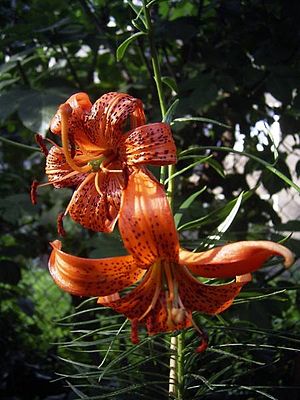David's lily
| David's lily | ||||||||||||
|---|---|---|---|---|---|---|---|---|---|---|---|---|

David's lily ( Lilium davidii ) |
||||||||||||
| Systematics | ||||||||||||
|
||||||||||||
| Scientific name | ||||||||||||
| Lilium davidii | ||||||||||||
| Duch. |
The David's lily ( Lilium davidii ) ( Chinese 川 百合 , Pinyin chuān bǎihé ) is a species from the genus of lilies ( Lilium ) in the Sinomartagon section . It is named after the French naturalist Armand David .
description
The David's lily is a perennial , herbaceous plant that reaches heights of 60 to 200 centimeters. The bulbs are strong and round, they reach a diameter of 4.5 cm-6 cm. They are covered with white lanceolate, after Fox egg-shaped scales, which turn red when exposed to the air. The stem is papillae and forms roots on the ground , sometimes it has a purple color. The lanceolate leaves are up to 3.5 cm long and up to 1.5 cm wide. They are distributed around the stem, but focus on its center and are shorter at the top than further down. The leaf base is hairy.
It blooms in July and August with a single flower or two to three nodding flowers in a panicle . The stem is up to 1.25 m high, rarely up to 2 m. The hermaphrodite, threefold flowers have six strongly curved back, up to 6 cm long, uniformly shaped bracts ( tepals ) with a glossy texture. The basic color of the flowers is orange to red with dark purple or black spots. The anthers are about 15 mm in size, the pollen are orange and the filaments are light green. The seeds ripen up to 3.5 cm long capsule fruits . The seeds germinate instantly and epigeously . The plant forms numerous root bulbs.
The number of chromosomes is 2n = 24, less often 12 or 36.
distribution
Originally the lily in the provinces of Gansu , Guizhou , Henan , Shanxi , Sichuan , Yunnan , west of the province of Hubei and the southern province of Shaanxi widespread. However, since it is grown as a food plant on a large scale, it can now be found in almost all of the People's Republic of China and on the Korean peninsula . To what extent these plants still correspond to the wild form is debatable. David collected his plants in the Moupin district , Forrest in the Tali Valley in the Li-Chang Mountains and on the watershed between Mekong and Salween . The plant collector Ernest Henry Wilson described the David lily in the valleys of the Min and Tung .
The David's lily needs a moist soil, it is often found on steep mountain slopes between grasses and small bushes or on boulders on which humus has accumulated, at the edges of the forest or on wet meadows at altitudes between 800 and 3200 m above sea level, according to Fox between 1500 and 3000 m.
Systematics
There are three varieties:
- Lilium davidii var. Davidii : leaves single-veined, hairy white tomentose in the leaf axils.
- Lilium davidii var. Wilmottiae (EH Wilson) Raffill : Central China, leaves three- veined , leaf axils hairless, curved stems, more flowers. The species is named after Ellen Willmott, the patron of Ernest Henry Wilson .
- Lilium davidii var. Unicolor (Hoog) Cotton : southern Shanxi, up to 1 m high, flowers pale orange instead of red, less mottled, purple spots (synonym Lilium sutchuenense )
cultivation
With its starchy onion, the David lily is perhaps the most popular edible lily in China and is therefore widely grown. The lily is broken up into individual scales and these are usually fried in hot oil. Dried lily scales are also used.
The strong color of the flowers and their sheen are dominant in crossbreeds, for this reason the lily has been used repeatedly for breeding purposes. The David's lily was crossed for the Preston, Northern and Patterson hybrids as well as the 'Fiesta' variety and it is present in most Asian varieties.
Cultures:
- Lilium davidii var. Macranthum (Raffill ex Woodcock & Coutts) Raffill : Cultivated by Raffil in Kew Gardens , up to 2 m high, orange flowers
- Lilium davidii 'Oriole' by Preston
As a garden plant, the lily of David needs acidic soils, but also thrives on slightly calcareous soils if there is a lot of humus in the soil. Botrytis can attack bulbs if the plants are too close together.
swell
literature
- Liang Songyun, Minoru N. Tamura: Lilium davidii . In: Wu Zhengyi, Peter H. Raven, Hong Deyuan (eds.): Flora of China . tape 24 . Missouri Botanical Garden Press / Science Press, St. Louis / Beijing 2000, ISBN 0-915279-83-5 , pp. 145 ( online [accessed February 3, 2009]).
Individual evidence
- ↑ a b c Derek Fox 1985, Growing lilies. Beckenham, Croom Helm, 115
- ↑ according to Fox up to 12 cm
- ↑ according to Fox up to 0.4 cm
- ↑ according to Fox up to 20
- ^ Tropicos. [1]
- ↑ a b Derek Fox 1985, Growing lilies. Beckenham, Croom Helm, 114f.
- ^ Ernest Henry Wilson 1925, The lilies of Eastern Asia, a monograph. London, Dulau & Co.
- ↑ a b http://www.pacificbulbsociety.org/pbswiki/index.php/LiliumAsiaticSectionTwo
- ↑ Derek Fox 1985, Growing lilies. Beckenham, Croom Helm, 115.
Web links
- Markus Hohenegger: Lilium davidii. In: The Genus Lilium. Retrieved February 3, 2010 .